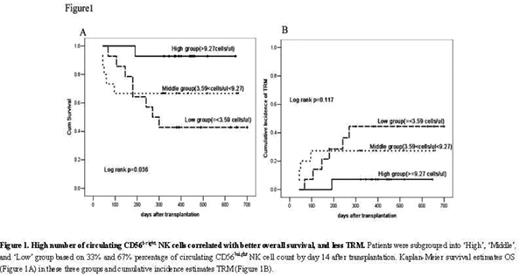Abstract
Objectives: The goal of this study was to investigate the association of natural killer (NK) cell recovery with clinical outcomes after unmanipulated haploidentical blood and marrow transplantation.
Methods: We sequentially monitored the reconstitution kinetics of circulating NK cells, CD56bright and CD56dim, in 43 patients by flow cytometry, and the functionality recovery of cytokine or cytotoxicity of NK cells by flow cytometry or LDH release assay after transplantation.
Results: Reconstitution of NK cells was rapid but accompanied by skewing of cell subsets mainly in CD56bright, which had a greater growing speed. Linear regression analysis demonstrated that dose of CD34+ cells in the allografts was inversely correlated with the ratio of T/NK cells (β=−0.506, P=0.003) and CD56dim/CD56bright cell (β=−0.403, P=0.018) by day 14 after HSCT, and dose of CD3+ T cells in the allografts was also inversely correlated with the ratio CD56dim/CD56bright cells by day 14 after HSCT (β=−0.474, P=0.005). Compared with non-acute graft-versus-host disease (aGVHD) patients, patients with aGVHD had a higher level of NK subsets during week 2 post-transplantation. Cox regression analysis revealed that the patients with more CD56bright NK cells in the recovery stage had a higher survival rate (hazard risk [HR], 0.353; p=0.019) and the patients with higher ratio of T/NK (>1.0) had a higher chance of getting aGVHD (HR, 3.889; p=0.034) and cGVHD (HR, 3.925; p=0.028).
Conclusions: Our results suggest that the recovery of NK cells is and can be used as an indicator to predicate the clinical outcomes after unmanipulated haploidentical transplantation.
High number of circulating CD56bright NK cells correlated with better overall survival, and less TRM. Patients were subgrouped into ‘High’, ‘Middle’, and ‘Low’, group based on 33% and 67% percentage of circulating CD56bright NK cell count by day 14 after transplantation. Kaplan-Meier survival estimates OS (Figure 1A) in these three groups and cumulative incidence estimates TRM (Figure 1B).
High number of circulating CD56bright NK cells correlated with better overall survival, and less TRM. Patients were subgrouped into ‘High’, ‘Middle’, and ‘Low’, group based on 33% and 67% percentage of circulating CD56bright NK cell count by day 14 after transplantation. Kaplan-Meier survival estimates OS (Figure 1A) in these three groups and cumulative incidence estimates TRM (Figure 1B).
Author notes
Disclosure:Research Funding: National Natural Science Foundation of China (grant no.30470753), Scientific Research fund for Capital Medicine Development (grant no.2006-1010) and Hi-tech Research and Development Program of China (No. 2006AA02Z4A0).


This feature is available to Subscribers Only
Sign In or Create an Account Close Modal